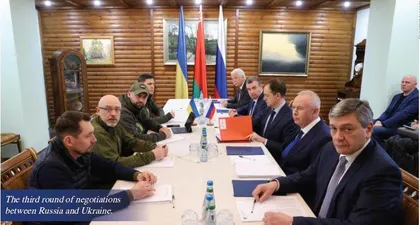Russia and the West Relations
作者: Pang Dapeng

On February 24th, 2022, Russia started to launch a special military operation on Ukraine. The Russia-Ukraine conflict erupted. The Ukraine crisis is not the problem of one single country, but the result of the evolving fundamental contradiction of the post-Cold War world. The basic state policy of Russia is to safeguard its sphere of influence in the former Soviet region and realize reintegration of the Commonwealth of Independence States (CIS), especially the three Slavic states of Russia, Ukraine and Belarus. The strategy of the U.S.-led West, on the other hand, is to maintain the status quo after the collapse of the Soviet Union and to infiltrate into former Soviet states, even supporting countries like Ukraine that are against Russia, in a bid to dismember the CIS and keep Russian influence within its borders. The problem between Russia and the West in the former Soviet region is structural and irreconcilable. President Putin’s special military operation, which sent Russian troops to Ukraine, has had a profound impact on the international pattern and world order.
The Russia-Ukraine Conflict: A Point of No Return
Rome wasn’t built in a day. Although a quarter of a century has passed since the fall of the Soviet Union, most people in Russia still feel frustrated and are reluctant to accept reality. President Putin is most bitter about it, having said that the dissolution of the Soviet Union is the “biggest geopolitical disaster in the 20th century”, an event that had the most impact on his life. The elites in Russia also hope that under strongman Putin, the former Soviet region could realign and bring the glorious days back.
The crux of the Ukraine problem or the Russia-Ukraine relationship is the relations between Russia and the West. The “color revolution” in Ukraine in 2003 saw the pro-Russia government replaced by a Pro-West one, which in the eyes of Russia amounted to geopolitical and ideological encirclement of Russia by the West. As a result, to prevent Ukraine from joining NATO became part of Russia’s foreign strategy. Ukraine is situated along a new geopolitical fault line to the West and Southwest of Russia, which runs from the Baltic States in the North to Central Europe, the Balkans, and to the Caucasus and Central Asia. Ukraine is thus the storm eye of a geopolitical power struggle.
On February 1st, 2022, Putin stated that Ukraine is just a chess piece for the U.S. to contain Russia and that the security of Ukraine is not something that the U.S. cares about. For Russia, there are mainly two reasons behind the escalation of tensions between Russia and Ukraine. One is that NATO has already taken Ukraine as an enhanced partner, with the U.S. markedly increasing its military cooperation with Ukraine, helping it to notably improve its military capabilities, which Russia believes threatens its national security. The other reason is that Ukraine has refused to implement the Minsk Agreement. As a result, the Minsk Process, which aims at political settlement of the issues concerning the eastern part of Ukraine, has become hard to implement, undermining the foundation for dialogues between Russia and Ukraine.
The Russia-Ukraine conflict reflects the changes in the international strategic pattern. From the perspective of the international situation, Russia has tried to grasp the crucial period when the power center of the world is shifting from the West to the East so as to seek maximum interests. It is the belief of Russian leaders and analysts that the international situation and balance of power is seeing profound changes that favor Russia: the U.S. decline is inevitable; Europe will completely lose its status of center of the world; and China will become a super power that will surely come into conflict with the U.S.. All these changes, they believed, would reduce possible external resistance to Russia’s special military operation in Ukraine.
Before the Russia-Ukraine conflict, there was a strong momentum in the Russian efforts at CIS integration. Russia had frustrated the Western attempts to topple the Lukashenko government and pressed ahead with the Russia-Belarus Alliance. It had been deeply involved in the Kazakhstan situation and maintained stability in Central Asia. On the Ukraine issue, it had been assertive and clearly marked the red line for its national security. The U.S., on its part, had shifted its strategic focus from Europe and the Middle East to the Asia-Pacific region and shown vulnerabilities in Afghanistan. Against the backdrop of more substantial confrontation between China and the U.S., Russia has taken a purposely aggressive and assertive strategy to maximize its interests in Eurasia.
Once the Russia-Ukraine conflict is over, a Russia with reduced power would lead to restructuring and regrouping of the regional order on the Eurasian continent. The economic and military power of Russia has been diminished because of the conflict, hence its reduced power of control in its neighborhood. President Tokayev of Kazakhstan has declared its New Kazakhstan development strategy, with unprecedented measures to realize political modernization of the country. Armenia, a military ally for Russia of the CIS Collective Security Treaty Organization, has voiced its willingness to develop sound relations with Türkiye. The Transcaucasian state of Moldova has even raised the possibility of solving the issue of Transdniestr. These developments would have been unthinkable before the conflict.
As a matter of fact, after the disintegration of the Soviet Union, due to the lack of appeal of the Russian development model, which falls short of galvanizing neighboring countries as an economic magnet, countries in the CIS region have accelerated their parting of company in terms of geopolitical security. The trend has become all the more obvious after the conflict. By far the only country that clearly supports President Putin’s operation and is deeply tied with Russia is Belarus. In a turbulent period with Russian power sliding, relevant countries might choose new foreign strategies. The prospect of fluidity or even regrouping of the regional order of Eurasia is inevitable.